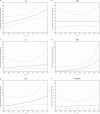A retrospective analysis of the prevalence of imprinting disorders in Estonia from 1998 to 2016
- PMID: 31186545
- PMCID: PMC6871525
- DOI: 10.1038/s41431-019-0446-x
A retrospective analysis of the prevalence of imprinting disorders in Estonia from 1998 to 2016
Abstract
Imprinting disorders (ImpDis) represent a small group of rare congenital diseases primarily affecting growth, development, and the hormonal and metabolic systems. The aim of present study was to identify the prevalence of the ImpDis in Estonia, to describe trends in the live birth prevalence of these disorders between 1998 and 2016, and to compare the results with previously published data. We retrospectively reviewed the records of all Estonian patients since 1998 with both molecularly and clinically diagnosed ImpDis. A prospective study was also conducted, in which all patients with clinical suspicion for an ImpDis were molecularly analyzed. Eighty-seven individuals with ImpDis were identified. Twenty-seven (31%) of them had Prader-Willi syndrome (PWS), 15 (17%) had Angelman syndrome (AS), 15 (17%) had Silver-Russell syndrome (SRS), 12 (14%) had Beckwith-Wiedemann syndrome (BWS), 10 (11%) had pseudo- or pseudopseudohypoparathyroidism, four had central precocious puberty, two had Temple syndrome, one had transient neonatal diabetes mellitus, and one had myoclonus-dystonia syndrome. One third of SRS and BWS cases fulfilled the diagnostic criteria for these disorders, but tested negative for genetic abnormalities. Seventy-six individuals were alive as of January 1, 2018, indicating the total prevalence of ImpDis in Estonia is 5.8/100,000 (95% CI 4.6/100,000-7.2/100,000). The minimum live birth prevalence of all ImpDis in Estonia in 2004-2016 was 1/3,462, PWS 1/13,599, AS 1/27,198, BWS 1/21,154, SRS 1/15,866, and PHP/PPHP 1/27,198. Our results are only partially consistent with previously published data. The worldwide prevalence of SRS and GNAS-gene-related ImpDis is likely underestimated and may be at least three times higher than expected.
Conflict of interest statement
The authors declare that they have no conflict of interest.
Figures


References
-
- Clayton-Smith J. A clinical and genetic study of Angelman syndrome. Doctoral dissertation, Manchester University, 1993.
Publication types
MeSH terms
Substances
Grants and funding
LinkOut - more resources
Full Text Sources
Research Materials

